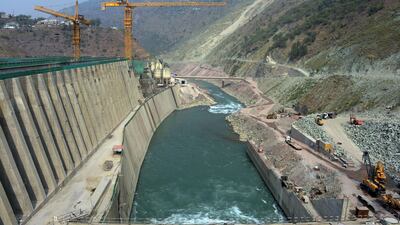Pakistan's supreme court has reinstated a ban on Indian television shows after the country's top judge reportedly railed against Delhi trying to block its neighbour's water supply.
Chief Justice Mian Saqib Nisar ordered the immediate halt, overturning a lower court ruling last year that had lifted an earlier 2016 proscription of Indian content on television or radio.
The judge made his decision in Karachi while hearing a case filed by producers' associations relating to the broadcasting of foreign content on Pakistan television channels.
"India is shrinking the flow of water into Pakistan," Mr Nisar reportedly said, as he overturned an earlier verdict by the Lahore High Court. "Why shouldn't we close their channels?"
The cross-border flow of film, music and performance has often become a victim of tit-for-tat reprisal between the nuclear-armed neighbours in their disputes over Kashmir, water and terrorism.
Earlier this year, India banned performances by Pakistani artists, and some Indian stations have stopped airing Pakistani content.
Indian producers have called for a comprehensive ban on Pakistani content, and Hindu extremists have threatened to attack cinemas showing films featuring Pakistani artists.
Pakistan's ruling covers terrestrial, satellite and cable channels.
Indian films and television are popular in Pakistan and many Pakistani actors and musicians find work in Bollywood. Khalid Arain, chairman of Pakistan Cable Operators Association criticised the order.
"A Ban on the all the Indian content is not the solution, rather we should try to better the quality of Pakistani TV shows,” he told reporters.
______________
Read more
Indian troops kill popular Kashmiri rebel leader
India and Pakistan trade insults after sideline meeting collapses
Opinion: Behind India and Pakistan's sabre-rattling lies a chance for change
______________
Pakistan's booming population and its dwindling water supplies have put water management high on the political agenda. With large parts of the country's water supply travelling through Indian-administered territory, the country also fears its neighbour will attempt to hold its water share hostage.
More than four-fifths of irrigated land in Pakistan depends on the Indus and its tributaries, most of which flow from the Himalayas. Access to the water is dictated by international treaty. But Islamabad views new hydroelectric schemes in Indian-administered Kashmir with great suspicion, suspecting Delhi of trying to siphon off more than its fair share of water.
Pakistan's chief justice has emerged as an unlikely champion of water management and an advocate for building dams. In a country facing an extreme financial crisis, he has hit upon the idea of crowdsourcing to raise the money needed to build two dams. Whipping up a sense of national purpose and tapping into a pride in large infrastructure projects, he has set up a fund to try and find $12 billion (Dh 44 billion) to build two.
Prime Minister Imran Khan has lent his weight to the campaign and Pakistanis are exhorted to donate at every turn. In his zeal, the chief justice has suggested anyone opposed to the building of the Diamer-Bhasha and Mohmand Dams is a traitor.
Mr Khan made a televised appeal for overseas Pakistanis to donate at least $1,000 each.
Yet the scale of the task is daunting and with current donation totals standing at around 1 per cent of what is needed.

